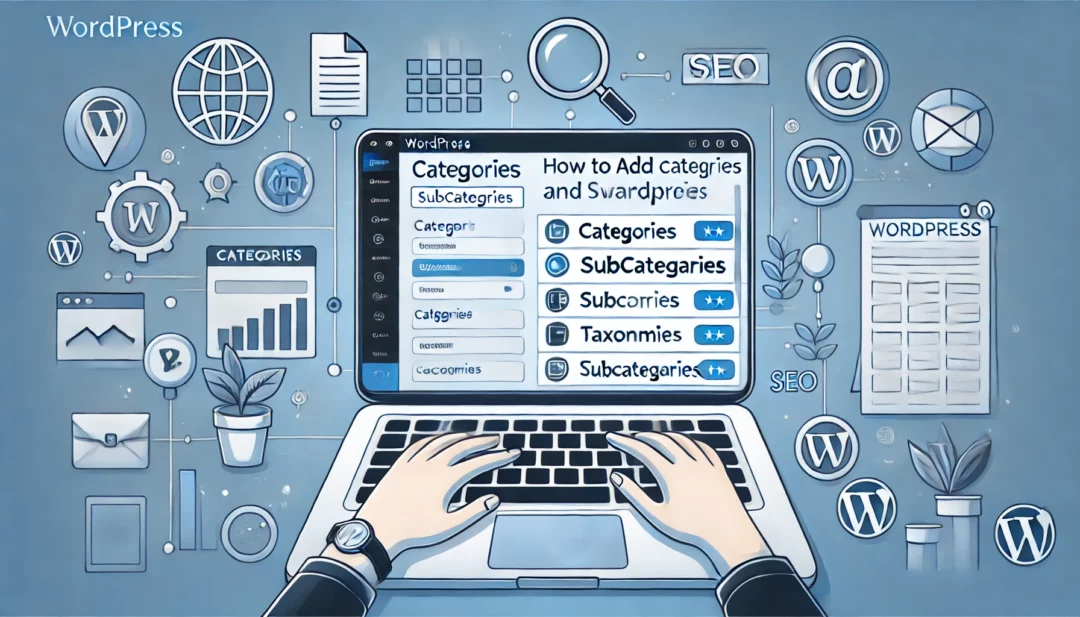
Organizing your WordPress site with categories and subcategories enhances navigation and improves user experience. Whether you’re running a blog or managing an online store, creating a clear content structure helps visitors find what they need quickly. Plus, it boosts your site’s SEO by making your content easier to index.
Adding categories and subcategories in WordPress is straightforward. You’ll start by accessing your dashboard, creating main categories, and then assigning subcategories to refine your structure. Once set up, you can assign posts to these categories, ensuring your content stays organized and accessible.
Why Use Categories And Subcategories In WordPress
Categories and subcategories structure your WordPress site by grouping related content. This organization improves user navigation and ensures visitors quickly find relevant information. For example, a blog on travel could use “Destinations” as a category and “Europe” or “Asia” as subcategories to organize posts efficiently.
Search engine optimization (SEO) benefits significantly from categories and subcategories. Properly labeled content is easier for search engines to index, which can improve your site’s ranking. For instance, posts categorized under “Fitness” with subcategories like “Yoga” or “Cardio” use targeted keywords that help search engines understand your site’s hierarchy.
Readers experience better engagement when content is well-organized. Categories reduce clutter by grouping content into distinct sections, while subcategories drill down into more specific topics. This clear structure encourages visitors to explore other parts of your site, increasing time spent on your site and lowering bounce rates.
WordPress offers built-in tools to create and manage categories and subcategories, simplifying content organization. This native functionality makes it easy to adjust your site’s structure as your content grows, ensuring scalability.
Preparing Your WordPress Site For Categories
Optimization of your WordPress site for categories is essential to ensure seamless navigation and usability. Proper preparation makes it easier to organize and manage content effectively.
Understanding The Role Of Categories
Categories in WordPress allow you to group related posts, supporting better navigation and content discovery. They function as broad topics under which your posts fit. For example, a blog about technology may use “Software” and “Hardware” as separate categories.
- Enhance Navigation: Categories help users browse content based on specific interests, ensuring a better user experience.
- Improve SEO: Search engines use categories as indicators of content structure, which can positively impact rankings.
- Content Organization: They streamline your site, making content management more efficient, especially as your site grows.
Use a logical, hierarchical approach when creating categories, ensuring clarity for both visitors and search engines. Avoid overlapping topics to prevent confusion.
Enabling Permalinks For SEO-Friendly URLs
Permalinks determine how your site’s URLs display to visitors and search engines. Setting up SEO-friendly permalinks is critical for categories to work effectively.
- Access Permalink Settings: Go to your WordPress dashboard, navigate to “Settings,” and select “Permalinks.”
- Choose A Structure: Select the “Post name” or “Custom Structure” option for cleaner and more readable URLs. Example:
yoursite.com/category/post-title. - Save Changes: After selecting the structure, click the “Save Changes” button to apply the configuration.
Testing the updated URLs ensures that the settings work without breaking existing links. Properly configured permalinks contribute to a better user experience and stronger SEO results.
How To Add Categories In WordPress
Organizing your WordPress site with categories improves navigation and ensures users find relevant content efficiently. Categories group related posts, streamlining your site’s structure and benefiting overall SEO. Below is a detailed guide to adding categories using WordPress tools.
Adding Categories Through The Dashboard
Accessing the dashboard allows you to create categories effortlessly. Follow these steps for correct implementation:
- Log In To WordPress
Navigate to your WordPress login URL and enter your login credentials.
- Go To Categories
In the WordPress admin dashboard, hover over “Posts” in the left-hand menu. Click on “Categories” from the expanded options.
- Add New Category
On the Categories page, locate the “Add New Category” section. Enter the category name in the Name field. If it applies, fill in the Slug field for a custom URL (leave it blank to auto-generate).
- Assign Parent Category (Optional)
If this category is a subcategory, use the “Parent Category” dropdown to select its parent. Skip this if it’s a primary category.
- Add Description (Optional)
Add a description to explain the purpose of the category. This may be useful for certain themes that display descriptions.
- Save The Category
Click the “Add New Category” button to finalize and save the category. The category now appears in the list on the right.
Adding Categories While Writing Posts
Using the post editor enables you to create and assign categories simultaneously. Here’s how:
- Open A New Or Existing Post
Go to “Posts” and select “Add New” or edit an existing post.
- Locate The Categories Box
In the right-hand Post Settings panel, find the Categories section.
- Create A New Category
Click “Add New Category” below the list of available categories. Enter the category name in the text field.
- Set Parent Category (Optional)
If needed, choose a parent category under the “Parent Category” dropdown before saving the new category.
- Assign Categories To The Post
Check the box next to the desired category to assign it to the post. You can select multiple categories if necessary.
- Save Or Update The Post
After assigning categories, save your changes by clicking “Publish” or “Update” in the post editor.
These methods allow you to effectively manage your site’s structure directly from the WordPress dashboard and while creating content.
How To Add Subcategories In WordPress
Adding subcategories in WordPress helps further refine your content organization, improving navigation and supporting better SEO. Follow the steps below to create subcategories and assign posts to them effectively.
Defining Parent And Child Categories
- Access the Categories Section
Log in to your WordPress dashboard. Hover over Posts in the left-hand menu and click Categories. This takes you to the management area for categories.
- Add a Subcategory
In the Name field, enter the title of your subcategory (e.g., “Europe”). Next, use the Parent Category dropdown menu to select the related parent category (e.g., “Destinations”). Add a description if needed, then click Add New Category.
- Verify the Subcategory
Locate the new subcategory in the list of categories. Subcategories appear indented under their parent category, confirming they’re properly nested.
- Edit Or Create a New Post
Open an existing post or create a new one. In the post editor, find the Categories section, usually located in the right-hand sidebar.
- Select the Subcategory
Check the box next to the relevant subcategory. If necessary, select both the subcategory and its parent category for more comprehensive grouping.
- Save Changes
Save or update the post to finalize the assignment. The post now appears listed under the selected subcategory on your site.
Properly using subcategories ensures a more organized site, enhances user navigation, and supports SEO initiatives.
Tips For Organizing Categories And Subcategories
Organizing your categories and subcategories effectively in WordPress improves navigation, enhances SEO, and ensures a seamless user experience. Follow these tips to create a well-structured layout for your site.
Keeping Your Structure Simple And Clear
Maintain clarity by limiting the number of categories and creating only relevant subcategories. Overloading your site with too many levels or complex structures confuses users and search engines. Use descriptive names; for instance, instead of “Blogs,” use “Tech Articles” or “Travel Stories” to clarify content.
Plan your category hierarchy before starting. Map out your main topics and decide which ones require subcategories. For instance, a food blog might group “Recipes” as the main category with “Desserts,” “Quick Meals,” and “Vegetarian” as subcategories.
Avoiding Duplicate Or Overlapping Categories
Prevent repetition by auditing and streamlining your categories. Check for duplicate or overlapping topics that may split content unnecessarily. For example, don’t create separate categories like “Tech Gadgets” and “Gadget Reviews” if they serve the same purpose.
Assign each post to the most relevant category. Avoid placing the same article in multiple categories, as this dilutes the structure and can confuse both visitors and search engines.
Conclusion
Organizing your WordPress site with categories and subcategories is a powerful way to improve navigation, boost SEO, and create a seamless user experience. By taking advantage of WordPress’s built-in tools and planning your category structure thoughtfully, you can ensure your content remains accessible and well-structured as your site grows.
A clear hierarchy not only helps visitors find what they need but also signals to search engines that your site is organized and relevant. With proper implementation, you’ll enhance engagement, reduce bounce rates, and set your site up for long-term success.
Frequently Asked Questions
What are WordPress categories and subcategories?
Categories and subcategories in WordPress are tools for organizing your content. Categories serve as broad topics, while subcategories are specific subtopics under a category. For example, in a travel blog, “Destinations” could be a category, and “Europe” or “Asia” could be subcategories. This structure improves navigation and makes it easier for users and search engines to understand your site’s content.
How do categories and subcategories improve SEO?
Categories and subcategories help search engines index your content more effectively. They create logical groupings and cleaner site structures, making your site easier to crawl and rank. This organization enhances user experience and encourages longer visits, which further boosts SEO rankings.
How do I create a category in WordPress?
To create a category in WordPress, log in to your dashboard, go to Posts > Categories, and fill in the category name, slug, and optional description. Click Add New Category to save it. You can also assign categories to posts directly during content creation or editing.
How do I add a subcategory in WordPress?
To add a subcategory, navigate to Posts > Categories in the dashboard. Enter the subcategory name, select the parent category from the dropdown menu, and click Add New Category. This will nest the subcategory under its designated parent category.
Can I add categories while writing a post?
Yes, categories can be added while writing a post. On the post editing screen, look for the Categories panel. You can select existing categories or click Add New Category to create one instantly. Assigning categories while writing helps keep your content organized.
Why is a clear category structure important?
A clear category structure improves user navigation and helps visitors find content easily. It also signals content hierarchy to search engines, boosting SEO. A well-organized structure keeps your site user-friendly and prevents confusion for both users and search engines.
How can I change my WordPress permalink structure?
To change permalinks, go to Settings > Permalinks in your WordPress dashboard. Choose a structure like “Post Name” that includes keywords and is SEO-friendly. Click Save Changes to update your site’s URLs. Proper permalinks enhance readability and search engine visibility.
How many categories should my WordPress site have?
It’s best to use a limited number of categories with relevant, descriptive names. Quality matters over quantity—avoid having too many categories, as it can confuse users. Plan your category hierarchy carefully to maintain a clean and simple structure.
Can a post belong to multiple categories?
Yes, a post can belong to multiple categories, but it’s recommended to assign it to the most relevant one. Overlapping categories can harm user navigation and confuse search engines. Keeping posts in appropriate categories ensures a more organized site.
How do I manage categories as my content grows?
Regularly review your categories to ensure they align with your content. Remove duplicate or outdated categories, merge similar ones, and update subcategories as necessary. This ongoing maintenance keeps your site structured, user-friendly, and optimized for SEO.



